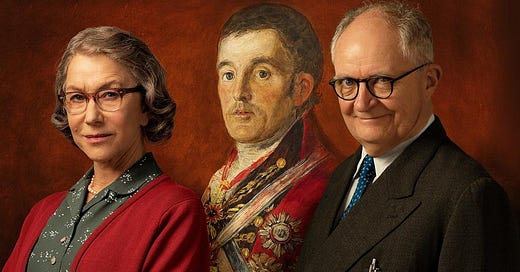The Duke
Jim Broadbent gives a twinkly, charismatic performance as an obscure Brit raconteur who stole a famous painting, with Helen Mirren as his long-suffering wife.
Oh, what a corker.
That’s a wonderful British slang term for Kempton Bunton, the real-life working-class Brit who in 1961 stole a famous painting, and also for “The Duke,” the new film about his escapade.
The great Jim Broadbent gives another masterful performance full of twinkly charm as Bunton, a 60-ish raconteur who lives to needle the establishment. He gets to deliver a lot of great speeches and witty one-liners, playing a man who is incapable of laying down when he sees anything he considers an injustice.
This extends as far as needing a license to receive BBC broadcasts on a television — yes, that was and is a real thing in the U.K. — which Bunton tries to get around by removing the coil inside his set to block that particular channel. He winds up going to jail for 13 days for his beliefs, which is a commentary about the tendency toward wackiness in his opinions, but also his willingness to stand behind his convictions, whatever they may be.
Kempton also writes constantly, mostly plays, none of which have every been staged. I’d be tempted to call him a frustrated playwright, except his lack of publishment seems not to bother him in the least. For a man like him, simply the act of expressing himself is the required balm to his soul, whether or not anyone actually listens to him.
The equally great Helen Mirren plays his wife, Dorothy, who works as a domestic in the home of a local elected official, and is constantly worried that Kempton’s latest idiotic crusade will threaten her position. That’s certainly less a concern for him, a fellow who goes through jobs like he changes socks, from taxi driver to bakery worker.
It’s always his big mouth, and his willingness to use it to upset those in authority, that leads to his dismissal.
Mirren has the clearly less showy role, almost unrecognizable as a pinch-faced woman who is defined by fear and resentment. She has plenty to resent, as her selfless toil is what keeps the family (barely) afloat. But Mirren also shows us the humanity behind the crabby exterior — a woman who has carried the weight for so long, and deserves to utter an occasional complaint. In particular, the accidental death of their eldest daughter years ago weighs heavily upon their marriage.
Their youngest son, Jackie (Fionn Whitehead), still lives at home and seems to be following in his father’s lackadaisical career path. Their oldest, Kenny (Jack Bandeira), is out on his own but engaged in ilicit activities. He’ll drop in from time to time to use the back bedroom when his fortunes suit, at one point bringing along a boisterous girlfriend (Charlotte Spencer), which is shocking to their blue-collar values, even if they aren’t religious.
Kempton’s latest hobbyhorse is a potrait of the Duke of Wellington by Francisco Goya, which he learns the British government has paid £140,000 for to keep it from being bought away by an American businessman. That’s about $3.5 million in today’s dollars, or as Kempton calculates, enough to pay for thousands of television licenses for military veterans and retirees.
During a two-day trip to London to make his voice heard — during which Kempton is ignored or tossed out of every notable institution — he decides to pay a visit to the National Gallery to gaze upon this expensive boondoogle. Soon it’s residing in the Bunton household, hidden in the guest room wardrobe.
This sets off a nationwide crime hunt to retrieve it, along with Kempton’s frenetic attempts, with the enlistment of Jackie, to keep it hidden from Dorothy. His requests that the price of the painting instead be used for television licenses is dismissed as a ridiculous distraction, and instead Scotland Yard searches for an international gang of expert art thieves… which at least has the benefit of throwing them off Kempton’s scent.
Even without cracking a history book or Googling, we know from the start that they did eventually catch him, since the film opens with the framing device of his criminal trial. We’ll eventually return to this setting for the last act, with the stubborn but folksy Kempton charming the pants off the gallery and press.
Matthew Goode plays his barrister, an affable high society type who sees his guilt or innocence as a lost cause, and is merely hoping to mitigate the damage: i.e., not send Kempton off to prison until his death.
“The Duke” is directed by Roger Michell (“Changing Lanes,” “Notting Hill”) from a screenplay by Richard Bean and Clive Coleman. It’s at once a delightfully entertaining film — part heist picture, part courtroom drama, part character piece — and a tribute to the peaceful renegades and daffy kooks who operate on the margins of society, generally ignored until they finally do something strange enough to gain our attention.
A running joke throughout the movie is that the Duke of Wellington is a very famous painting despite few people actually admiring it. “It’s not very good, is it?” someone repeatedly quips, or something like it.
Kempton Bunton was the opposite, a figure dismissed as unnoteworthy, until a quirk of fate made people realize he had something to say.





